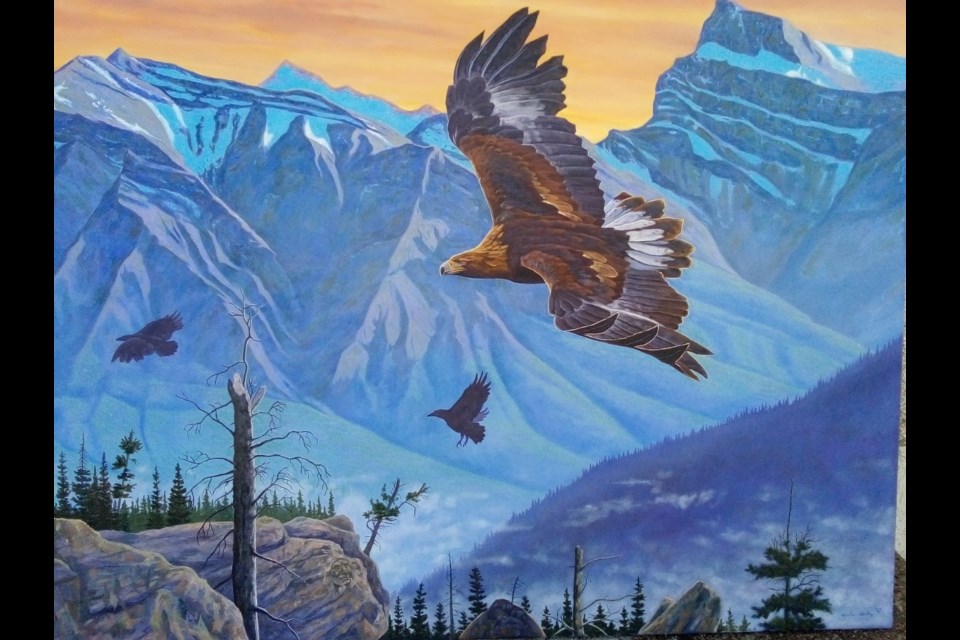STONEY NAKODA – A golden eagle flies high in the Rocky Mountains against a sun-drenched sky in one of artist Gordon Wesley’s four artistic works on display for the Land is Home project at the Inglewood Bird Sanctuary.
Stories from the Îethka, a series of three oil paintings and one pen and ink drawing by the Îyârhe (Stoney) Nakoda First Nation artist, is the fall installment of a year-long rotating art exhibition series from the City of Calgary highlighting the work of Treaty 7 Indigenous artists and their connection to the land.
For Wesley, who is originally from and still resides in Îyârhe Nakoda’s remote Big Horn reserve about 160 kilometres north of Mînî Thnî, it was not difficult to draw inspiration for the project having eagles, grizzly bears and, at one time – bison, as next-door neighbours.
“Most of my artistic vision is based on our homeland, where we live along the mountains,” said Wesley. “Growing up, I fell in love with the landscape and the wildlife.”
An appreciation for the beauty of the natural world grew from tradition. From an early age, he followed his father, Dion Wesley, into the wilderness learning to trap and hunt – like his father before him.
“My father used to be a guide for an outfitter and my brother was as well, so I went out on a lot of hunting trips,” said Wesley. “Trapping and hunting was a big part of my life and it exposed me to this new way of looking at the world.”
Wesley’s paintings depict more than beautiful landscapes, each frame spotlights culturally significant wildlife or subtle references to his ancestors.
One of the paintings, a 36- by 48-inch piece titled “On Sacred Ground,” depicts a herd of bison grazing on a meadow of grasses and wildflowers in the foreground, with a traditional Sundance lodge behind them and the sun setting against the mountains in the background.
The Sundance is a sacred ceremony practiced by several First Nations in the prairie provinces; its purpose to reaffirm spiritual beliefs about the universe. It was banned by the Indian Act but generally ignored and then dropped from the Act in 1951.
Part of keeping that tradition alive is through artistic expression, said Wesley, who comes from a long line of artists and creatives.
The same man who taught him to trap and hunt also taught him to paint. In addition to being a skilled hunter, the late Dion Wesley was a famous painter whose work has been featured throughout Alberta, with some of his last works displayed at Stoney Nakoda Resort and Casino.
Wesley’s uncle, Îyârhe Nakoda elder Roland Rollinmud, is an acclaimed artist whose list of accomplishments includes a federally-commissioned painting at the Cave and Basin National Historic Site, features at the Lifeways Gallery in Canmore and the Citizenship Pavillion at the top of the Banff Gondola, as well as a published picture book titled My Life’s Work – 2018. One of his works, titled “The Sundance,” depicts a similar scene to that of “On Sacred Ground.”
Wesley said he hopes his exhibit at the Inglewood Bird Sanctuary in Calgary can serve to inspire a young up-and-coming generation of Indigenous artists.
“I hope others who are just starting out can see themselves in this art,” he said.
The work of another Îyârhe Nakoda artist, Kelsey Twoyoungmen, was featured in the sanctuary’s summer exhibition titled Divine Feminine. One of Twoyoungmen’s digital art pieces depicts a Sailor Moon-like figure transforming into a jingle dress dancer as their superpower. A tune reminiscent of the anime show’s theme song plays in the background and transitions to Electric Pow Wow Drum by The Halluci Nation as the dancer takes form.
Her work was featured alongside Blackfoot artists Zoe Buckskin and Hali Heavy Shield of Kainai First Nation.
Jessica McMann, Indigenous curator with the City of Calgary, said only three per cent of the city’s public art collection consists of Indigenous-produced art.
Of that, neither the Tsuut’ina or Îyârhe Nakoda First Nations of Treaty 7 are represented.
“We have some Blackfoot pieces, we have some Inuit art and we have some pieces from Métis and Cree artists,” said McMann. “But we don’t have any artwork in the collection by artists in those two communities.”
In the spirit of reconciliation and providing equal representation, the City recently put out a call for Îyârhe Nakoda female and two-spirit Indigenous artists to apply for an opportunity that would see their textile art hung on the walls of council chambers in the years ahead.
There will be similar submission calls in the future for artists from the Blackfoot Confederacy, the Tsuut'ina Nation and the Métis Nation of Alberta to showcase textile arts such as beadwork, weaving, felting or quillwork. The winning artists will each be paid up to $20,000 to help cover their time and cost of materials.
Wesley’s work will be on display at the Inglewood Bird Sanctuary until Jan. 15, at which time the last exhibit in the Land is Home project, A Time for Stories, will take its place. The winter exhibit will feature a sound installation by Sonny-Ray Day Rider, of Kainai First Nation, a moss bag installation by Amy Hill, of Siksika First Nation, and a painting by Shirley Hill, also of Siksika First Nation.
The Local Journalism Initiative is funded by the Government of Canada. The position covers Îyârhe (Stoney) Nakoda First Nation and Kananaskis Country.




